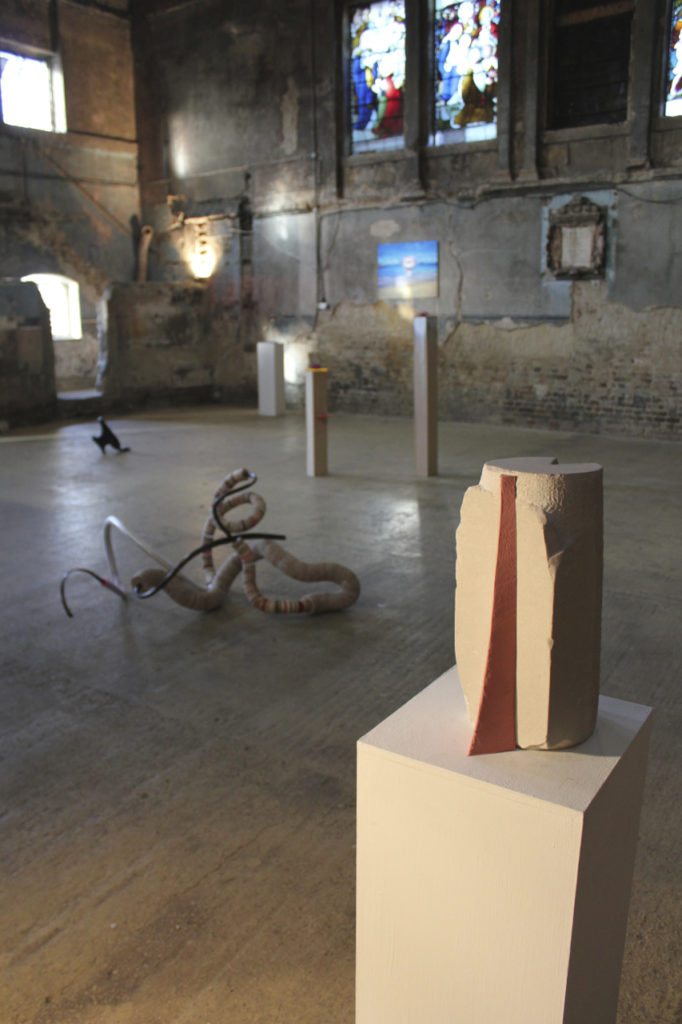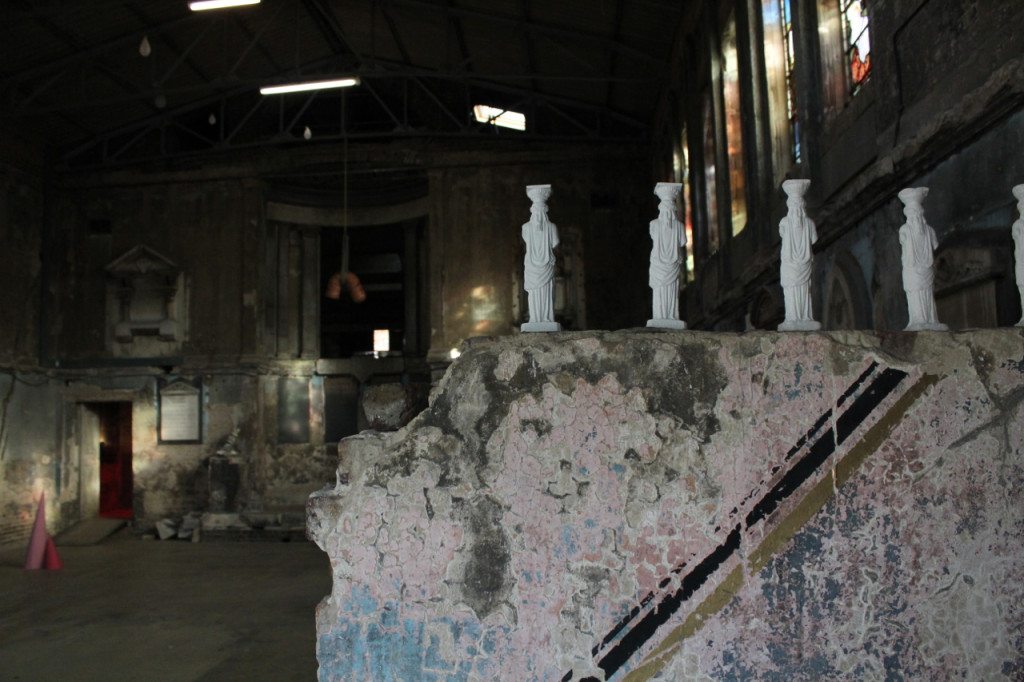Novelty: what validates art, if not newness?
There’s a fine line between newness and novelty. It’s a line that divides the illustrious and the new from the tacky. It separates the alluring from that which will last. This is the core of NOVELTY.
Novelty is a contemporary art exhibition which foregrounds questions of old and new, and pushes the boundaries of exhibiting art by staging a show about newness in a crumbling old chapel. Curated by Rachel Eliza Guthrie and Josh Berry, this exciting project is the pair’s second collaboration, following on from ∞: Time and Space held in Bermondsey in April 2013.
Arriving at the gallery was an intriguing but bewildering experience: a red-tinged steam (the heaters were the source of the red colour) was emerging from beneath the closed doors of a pillared 19th century chapel, and on entering the room, the works of art were not immediately obvious. Though the art was on display, it was also in some way cleverly hidden. New and old; hidden and clear – these were just a few of the tensions this exhibition confronted.
It is difficult to introduce Novelty briefly, but according to Berry, this project ‘grew out of a frustration about the way fashion turns over.’ Guthrie, an aspiring Art Critic, gives us an introduction to Novelty’s aims. ‘The show challenges contemporary art’s need to present something new, and the value of the new as a defining feature of art. It asks, is an artwork good just because it exhibits newness? And if it isn’t, what else validates it?’
The unusual choice of location was very deliberate. The pair wanted to avoid holding this show in a ‘white box’ gallery (four white walls and nothing else) and so were enthused to find Asylum, in Peckham. However, the Grade Two listed building presented curatorial challenges because they were only allowed to use the holes which already existed in the walls and there were fears that the art might be fighting for attention with its surroundings. ‘Each space could be a painting in itself,’ commented Guthrie, noting the double nature of the space as arresting but also a potential distraction. Rather than distracting, though, the choice of venue worked well to prompt questions around the juxtapositions of the new and the old.
The pieces which worked best in this space were the sculptures and objects, because they added a new dimension to an already visually rich location. Particularly successful were the installations hanging from the ceiling, or placed nonchalantly on the partially crumbled walls or smooth, stone floor. These were daring and difficult ways to install the works, and as a young team on their second show, working more-or-less alone, it was a triumph for instance to hang Daryl Brown’s large, abstract sculpture I’m Not Playing Anymore in the cavernous space above where the altar would have been. Hanging in a sling and looking like something between a newly-hatched caterpillar and a severed finger, it filled the space to create a powerful focus point for the room.
Beneath this sculpture, resting against the would-be altar, lay a prayer cushion embroidered with David Attenborough’s face, by Cheryl Field. This humourous piece declared our public investment in ‘national treasures’ but also brought out issues surrounding ‘novelty’. In seeing a TV personality on a prayer cushion, it forced you to confront the idea of a religiously devotional attachment to celebrities.
[pullquote style=”left” quote=”dark”]This clash of craftsmanship and modern popular culture is a theme that comes across strongly in the vision for the show.[/pullquote] Speaking about Novelty, Beatriz Acevedo, whose sculptures were on display, said, ‘There are many different works but also a common link somehow – there are blends and clashes, a coming together and pulling apart.’ This was particularly evident in her own piece Split which like its surroundings was made from stone, drawing visual comparisons to the floor and walls of the gallery. Unlike the surroundings, Split was abstract, uniquely carved with a slice of pink material in its centre. It could have been a face, a body, or a building. This ambiguity was completely absent from the carved flourishes which surround the plaques on the walls of the venue. As Acevedo said, this exhibition was a pulling apart and a coming together.
The show walks a fine line between the illustrious and refreshing, and the tacky. It draws out questions regarding the contemporary art movement, which is clear in Berry’s own work, Untitled. The photograph shows three urinals resting up against a skip, which knowingly parodies Marcel Duchamp’s now infamous urinal. Matt Gee’s Fruit of The Sea takes on this idea of the found object becoming art. Formed of two images found online, Gee’s working process for this piece seems to be almost non-existent. Do we consider his work to be found art, like Duchamps’ Fountain? Does his collation of the images and then choice of size and materials for printing them mean that this piece is something more than just found?
‘The artists on display here are definitely ones to watch,’ commented Katherine Savage, a visitor to the show. She talked about Acme by Kostas Synodis:‘It’s witty and cartoonish. It highlights the absurdity of industrial chemical tools.’ Synodis’ other work exhibited, Nine, makes an especially interesting assertion, that something mass-produced loses its value and its beauty. Displayed as it is on the top of a half-destroyed wall, the piece was one of the strongest in the gallery, giving a clear message as well as being aesthetically interesting. It consists of a series of reproductions of the same Greek-esque statue, which are identical except that they become increasingly blurred and eroded. Beneath the figures, a series of names, perhaps of chapel attendees, were partially visible, partly chipped away. Two sets of crumbling identities, names and faces, somehow combined to make something startlingly new.
The curators of this show are just beginning their artistic careers. Berry is in the process of completing his art degree at the University of East London, and Guthrie is a recent Warwick graduate. In an interview with South London Art Map, Berry responded to the idea that it was bold to curate a show while still an artist in training: ‘I don’t really know, Damien Hirst ran Freeze 25 years ago and I think he was in his second year [of art school…] you do need to be bold.’ Novelty is certainly bold, and Guthrie and Berry should dare to be bold again, because the boldness worked. A memorable and refreshing show.



Comments